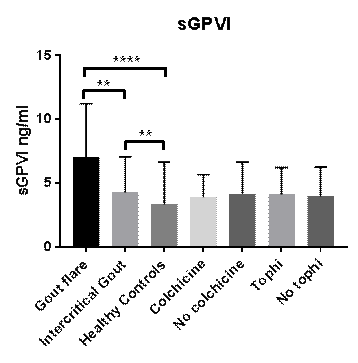Session Information
Date: Tuesday, November 15, 2016
Title: Metabolic and Crystal Arthropathies I: Mechanisms of Disease
Session Type: ACR Concurrent Abstract Session
Session Time: 4:30PM-6:00PM
Background/Purpose: Patients with gout have an increased risk of cardiovascular events. The presence of tophi is associated with enhanced cardiovascular risk. Increased platelet reactivity is a risk marker for cardiovascular events. The glycoprotein VI (GPVI) receptor is found exclusively on platelets and megakaryocytes and is the predominant platelet receptor for collagen. It remains intact on platelets under resting conditions. The proteolytic cleavage of GPVI occurs upon specific activation of platelets and is detectable in plasma as soluble GPVI (sGPVI). Therefore elevated plasma sGPVI is a marker of platelet activation and a risk marker for adverse cardiovascular outcomes. The aim of this study was to assess platelet activation, as measured by plasma sGPVI level in gout.
Methods: Following ethics approval and informed consent, blood samples were taken from patients with gout. Control samples were obtained from healthy volunteers. Demographic and clinical data were collected for all participants. Blood samples were processed as double spun platelet poor plasma. Plasma sGPVI levels were measured using ELISA. Mann-Whitney U test was used to compare groups. Spearmans Rank Correlation Coefficient was used to assess for associations between sGPVI and demographic and clinical markers. IBM SPSS Statistics Version 20 was used for data analysis.
Results: 121 patients were included, 27 during gout flare, 41 with intercritical gout, and 53 healthy controls. There were no significant differences in demographic details between the groups. Median (IQR) sGPVI levels were 6.51 ng/ml (4.52, 8.41) in gout flare, 3.58 ng/ml (2.11, 5.55) in intercritical gout, and 2.19 ng/ml (1.72, 3.31) in healthy controls.Plasma sGPVI levels in both gout groups were significantly increased compared to healthy controls (p<0.005 for each) (Figure 1). sGPVI levels were significantly increased in gout flare compared to intercritical gout (p=0.001). There was no significant difference in sGPVI levels in gout patients with and without tophi, median (IQR) 3.58 (2.26, 6.08) vs 2.94 (1.91, 6.01) (p=0.441), or in those prescribed colchicine, median (IQR) 3.60 (2.19, 6.06) vs 3.12 (2.12, 6.49) (p=0.773). There was moderate correlation between sGPVI levels and VASPain (r=0.40), and VASQOL (r=0.33). There was a weak correlation with CRP (r=0.23) and no correlation with ESR (r=0.049). sGPVI level did not correlate with presence of tophi (r=0.115) or colchicine use (r=0.042).
Conclusion: Patients with both tophaceous and non-tophaceous gout exhibit platelet hyperactivity as demonstrated by elevated plasma sGPVI levels. Platelet activation is exacerbated during acute gout flares. Colchicine therapy does not influence plasma sGPVI levels. Platelet activation probably contributes to the elevated cardiovascular risk in gout patients and antiplatelet therapy warrants consideration in this patient population. Figure 1
To cite this abstract in AMA style:
Conway R, Murphy CL, Madigan A, Kavanagh P, Geraghty L, Redmond N, Helbert L, Carey JJ, Dunne E, Kenny D, McCarthy GM. Increased Platelet Reactivity in Gout: Relationship to Tophus Burden and Colchicine Use [abstract]. Arthritis Rheumatol. 2016; 68 (suppl 10). https://acrabstracts.org/abstract/increased-platelet-reactivity-in-gout-relationship-to-tophus-burden-and-colchicine-use/. Accessed .« Back to 2016 ACR/ARHP Annual Meeting
ACR Meeting Abstracts - https://acrabstracts.org/abstract/increased-platelet-reactivity-in-gout-relationship-to-tophus-burden-and-colchicine-use/

